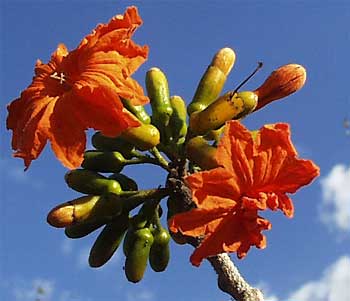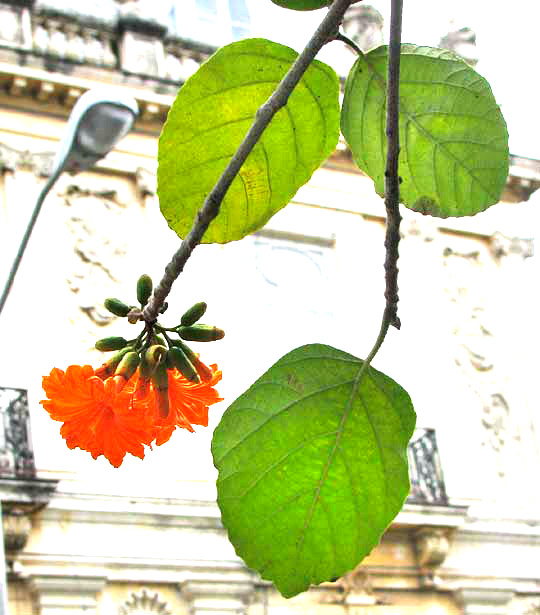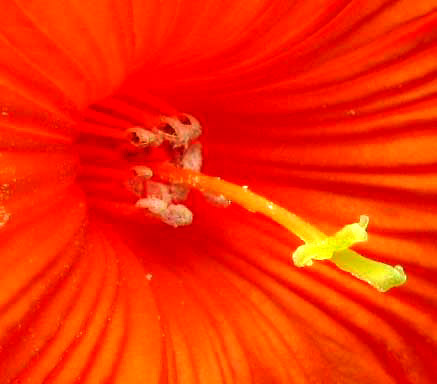Excerpts from Jim Conrad's
Naturalist Newsletter
from the February 25, 2006 Newsletter issued from near Telchac Pueblo, Yucatán, MÉXICO
ORANGE CIRICOTE FLOWERS AGAINST THE BLUE SKY

Our bright, blue-skied afternoons highlight a certain small, native tree blossoming now with orange-red blossoms about 2½-inches across. It's the Ciricote, CORDIA DODECANDRA, a member of the Borage Family, in which we also find Bluebells, Forget-me-nots, Comfrey and Borage itself. In the North this family is nearly always herbaceous but in the tropics it breaks out with woody species.
Ciricote's keep flowering for months at a time. During the wet season the flowers' intensely orange color erupts against a dark, green landscape. Now during the dry season Ciricote trees have lost their large, sandpapery leaves but the trees' flower clusters at the tips of scraggly branches are almost shockingly vivid against the deep, blue sky. The ones shown above were photographed right outside my door.
Many Ciricotes have been planted at the hacienda but out in the scrub they are not common, though once they were. One problem for the tree is that its wood is famous for holding up under wet conditions, plus the wood is pretty enough for being used in making furniture. I read that it has been placed on a list of plants in danger of disappearing from the wild.
from the April 18, 2010 Newsletter issued from Hacienda Chichen Resort beside Chichén Itzá Ruins, central Yucatán, MÉXICO; limestone bedrock, elevation ~39m (~128ft), ~N18.52°, ~W95.15°
CIRICOTE PUNCTUATION
Here and there in Mérida, neither common nor rare, small, native Yucatec trees known as Ciricotes, CORDIA DODECANDRA, bore reddish-orange, 1-½ inch long flowers, as shown below:

In the arid scrub surrounding Mérida Ciricote trees now at the end of the dry season mostly are leafless, so open clusters of flame-colored flowers terminate curved stems the way fireworks explode at the end of a rocket's gently arcing trajectory. But most Ciricotes I saw in Mérida, maybe with roots in drainage channels below the city, still bore rough-hairy, six-inch-long leaves, as in the picture.
Ciricotes were too uncommon to imprint whole streets with their character the way Pink Tabebuias and Lebbeck-Trees did. They were landscape punctuation, not whole sentences as were those two.
An interesting feature of the genus Cordia, to which Ciricote belongs, is its "4-lobed style," the style being the ovary's "neck," and ending with stigmatic zones where pollen germinates. You can see the long, reddish-orange style emerging from about ten stamens at the corolla's throat, and tipped with yellow lobes, below:

I interpret the conspicuously yellow lobes as simply announcing themselves as landing pads for pollinating insects who will leave their pollen at the stigmas, then follow the style to nectar down deep in the corolla tube. Finally, when they exit the flower the last thing they'll touch will be the stamens' anthers, in the picture covered with whitish pollen. The pollinators then will carry this pollen to other blossoms.